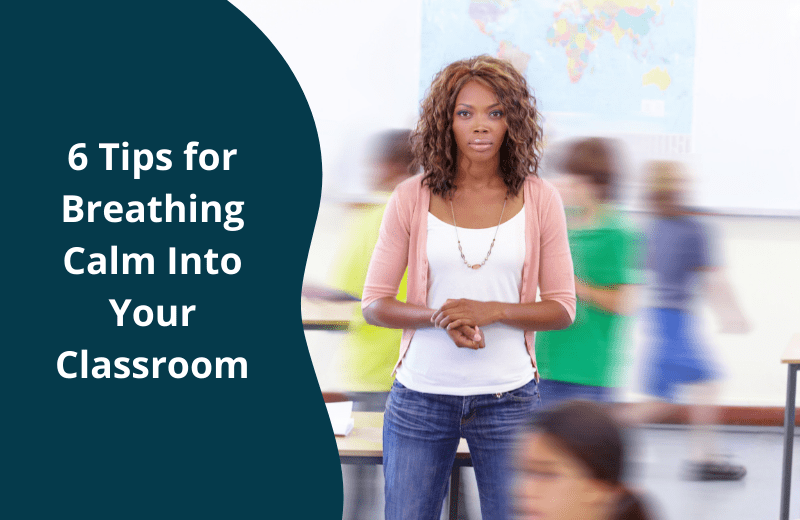No child is born with the ability to self-soothe, calm down when upset, or regulate emotions. As they grow, children learn to calm down by the way they are soothed by parents and caregivers, by watching others, and by experimenting with what works for them. Teaching your students a few simple SEL-based breathing strategies can make a big difference in how they learn to calm down and in establishing a positive, safe and supportive classroom environment. Deep breathing is a skill that is very effective when a child is unfocused, under stress, struggling with anxiety or having a meltdown.
Deep breathing has been scientifically proven to combat stress and anxiety in both adults and children. With children, deep breathing is an essential technique to learn to help with self-regulation, paying attention and focus, because it deactivates the sympathetic nervous system responsible for the fight, flight, freeze response.
When a child goes into their fight, flight or freeze response, their heart rate increases and their breathing becomes rapid and shallow. This blocks the flow of information to the prefrontal cortex and hippocampus, the two very important parts of the brain responsible for making decisions, learning new things and for remembering previously learned material. This makes it all the more important to practice good breathing techniques and get the brain back on track.
These six breathing techniques are extremely effective and easy to learn.
- Teach your students to breathe slowly in through their nose, out through their mouth. The best way to teach this method is to model the technique and have them do it at the same time as you while you give them the verbal cues of “in through your nose” and “out through your mouth”. A Hoberman Sphere, or belly ball, can be used as a visual tool to help your students connect to their breath by observing it. Our lungs are very similar to a Hoberman Sphere because they expand when you inhale and contract when you exhale. Linking the opening and closing of the Hoberman Sphere to your student’s inhales and exhales serves as a visual aid to observe the breath. The students practice slowing and deepening their breath.
- Have the students put their hands on their stomachs and feel the rise and fall while they experiment with breathing in and out. Younger students love to lie down on their back and use a small stuffed animal on their belly. Have them breathe in and watch it go up and then breathe out and watch it go down. This helps teach kids to use their bellies to access those deep breaths. It is also fun to use plastic frogs or ducks at any age. And with some of my older students, I have used a sensory stone in place of the hand.
- Teach students the balloon breathing technique. Have your students imagine that they have a balloon in their belly. As they breathe in through their nose they fill their “belly balloon” with air, hold the breath for 2 seconds and then breathe out through your mouth making the balloon deflate. I like to use a real balloon to demonstrate this when I’m teaching this technique. This balloon lesson can also lead to a mindful movement game called Balloon Volleyball where children are challenged to keep the balloon in the air as it moves in slow motion.
- Teach your students pinwheel breath. You will need a pinwheel for yourself and one for your students. Use the pinwheel to notice different ways of breathing —quick, slow, deep, and shallow— and the effect on how our minds and bodies feel after those breaths. First, blow on the pinwheels in long deep breaths and ask the students how it feels after a few breaths. Ask if it was easy or hard to stay focused on the breath. Then have the students blow on the pinwheels with slow, quick breaths and ask how that feels in their body. Ask if it feels the same or different. And ask which one makes their body feel better.
- Blowing bubbles is another great strategy to teach kids as a calming technique. They have to breathe slowly and carefully into the bubble wand in order to blow good bubbles. It helps children to slow down breathing and bring their bodies back into a state of relaxation. This bubble recipe is easy to make and if you don’t have a bubble wand handy, you can create a loop at one end of a pipe cleaner and use that for your wand.
Bubble Recipe:
1 1/2 cups warm water
1/2 cup clear dish soap
1/4 cup light corn syrup
optional: add a drop of purple food colouring (purple- a calming color)
- 5-4-3-2-1 is one of my favorite calming techniques. This exercise will help your students calm down, relax, and enter the present moment. For this one, ask your students to first take five deep breaths. Then ask them to find 5 things they can see, 4 things they can hear, 3 things they can touch, 2 things they can smell, and 1 thing they can taste. By the time they have done these 5 things, they will be calm, present, and ready to learn.
It’s important to have a few scripts ready when one of your students is distressed so that you can quickly de-escalate the child, and deactivate the sympathetic nervous system. This will allow you to be ready to talk them through this deep breathing process at any moment. For example: repeating “in through your nose, hold for 3 seconds, out through your mouth”, “let’s fill your belly balloon” or “let’s do bubble breath”. These should be short and simple.
Plan to practice these techniques several times a day. It takes only one minute but adds valuable teaching time because your students are focused and ready to learn. Ideally, if you practice breathing techniques every day, they become a habit by forming motor muscle memory and will be easier for your students to access during times of distress in and out of the classroom.
For more great breathing exercises and activities check out our Breath Deck on Teachers Pay Teachers. Use our professionally designed mindful card deck, which includes 10 cards and lessons. When you purchase this card deck, it is ready to easily print and use. These are amazingly effective SEL instructional materials. Create the classroom environment of your dreams by working in just minutes of SEL every single day.
You are also invited to join us on Wednesdays at 8:15 am EST to further your own mindful prac










